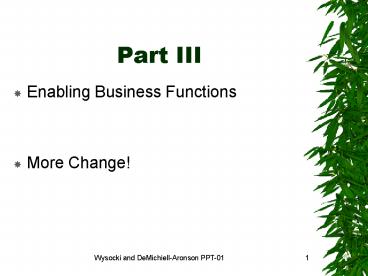Enabling Business Functions - PowerPoint PPT Presentation
1 / 25
Title:
Enabling Business Functions
Description:
IS dept establishes a small liaison staff for communicating with user business units ... Centralized software control. Systems development training (esp. for ... – PowerPoint PPT presentation
Number of Views:54
Avg rating:3.0/5.0
Title: Enabling Business Functions
1
Part III
- Enabling Business Functions
- More Change!
2
11. Linking Information Technology to Business
Functions
- Duh!
- Integral part or organizational planning
3
Decision Making
- See DSS Book, Chapter 2, 3, 10
- Decision-making relationships in the enterprise
Exhibit 11-1 Interesting
4
Business Applications and Information Technology
- Corporate planning
- Marketing
- Manufacturing, production scheduling, inventory
- Accounting and finance
- Human resources
- E-commerce
5
Business Applications and Information Technology
- IT is an octopus
6
End Chapter 11
- Chapter 12 starts on next page
7
12. Systems Development Methodology
- See DSS Chapter 6
8
Taxonomy for Development
- Maintenance projects
- System upgrade projects
- New applications development
- All part of the IS/IT portfolio
- Project management
- Data models (data flow, entity-relationship)
9
End Chapter 12
- Chapter 13 starts on next page
10
13. Information Technology at the End User Level
- End user computing (EUC)
- End user development (EUD)
- More so now with improved business intelligence
(BI) tools like OLAP
11
Types of End Users
- Type I Information worker given tools and
instructions - Type II worker understands general goals and
figures out how to reach them - Type III Executive (EIS)
12
Importance of End-User Computing
- Users get what they want when they want it
- IS people dont need to become functional
specialists - Quality control issues
- Data control issues
- Control and certification issues
- Users and their expectations must be managed
13
Electronic Commerce
14
End Chapter 13
- Chapter 14 starts on next page
15
14. The Support Role of Information Technology
16
Developing a Support Service Level Agreement
- Helps manage expectations
17
Roles and Responsibilities
- Environment (both IS and users)
- Setting corporate policy and standards
- Data administration
- Communications
- Technology research
- Training and education
18
End-User Management Responsibilities
- Applications management Implementation strategies
19
Implementation Policies and Procedures
- Open communications link between IS dept and
systems people in user depts - Procedures to update data
- One person in each user area responsible for
operations, critical data maintenance, and
communicating procedural matters - IS dept establishes a small liaison staff for
communicating with user business units
20
The Life Cycle of End-User SystemsFuzzy
21
Issues
- Hard and soft controls
- Maintenance
- Central purchasing
- Training
- Shared data
- Centralized software control
- Systems development training (esp. for error
checking) - Communications
22
Certifying User-Developed Systems
- A licensing procedure
- Individual
- Work group
- Organizational
23
Epilog Positioning the Enterprise for the Future
through People and Technology
- Web/Internet
- Web/Internet
- Web/Internet
- Web/Internet
- Web/Internet
24
Fully Integrate
- Information Technology
- Business Processes
- Staff
- Cut a clear path through the cube!
- Manage change effectively and it will be a
positive experience
25
End Chapter 14 / End Part II

